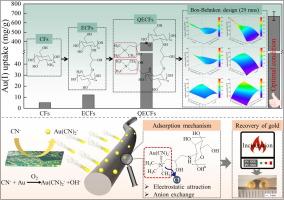Rapid and efficient recovery of Au(I) from cyanide gold leachate via quaternary ammonium-functionalized chitosan fibers: Insights into synthesis mechanism and adsorption behavior
IF 8.1
1区 工程技术
Q1 ENGINEERING, CHEMICAL
引用次数: 0
Abstract
For recovering gold from gold cyanide (Au(I)) leachate, quaternary ammonium (R4N+) functionalized chitosan fibers (QECFs) were developed. The synthesis process was finely tuned via the Box–Behnken design to maximize Au(I) adsorption efficacy. Additionally, the environmental impacts and estimated manufacturing costs of preparing QECFs were assessed through life cycle assessment and economic analysis. The QECFs demonstrated exceptional maximum adsorption capacities of 669.75 ± 47.20 mg/g at pH = 9.5 within 15 min, surpassing reported adsorbents in both capacity and rate. Comprehensive characterization of adsorbents and mechanisms was conducted using DFT conclusion, FE-SEM, FT-IR, and XPS. The findings elucidated those electrostatic interactions between the R4N+ on QECFs and Au(I), along with anion exchange involving Cl− and Au(I), are integral to the adsorption mechanism. Furthermore, the QECFs could be swiftly regenerated using NaCl solution. The practical application of QECFs yielded a remarkable recovery efficiency of 98.2 % for Au(I) from WPCBs leachates, underscoring their potential utility in the gold recovery.

求助全文
约1分钟内获得全文
求助全文
来源期刊

Separation and Purification Technology
工程技术-工程:化工
CiteScore
14.00
自引率
12.80%
发文量
2347
审稿时长
43 days
期刊介绍:
Separation and Purification Technology is a premier journal committed to sharing innovative methods for separation and purification in chemical and environmental engineering, encompassing both homogeneous solutions and heterogeneous mixtures. Our scope includes the separation and/or purification of liquids, vapors, and gases, as well as carbon capture and separation techniques. However, it's important to note that methods solely intended for analytical purposes are not within the scope of the journal. Additionally, disciplines such as soil science, polymer science, and metallurgy fall outside the purview of Separation and Purification Technology. Join us in advancing the field of separation and purification methods for sustainable solutions in chemical and environmental engineering.
 求助内容:
求助内容: 应助结果提醒方式:
应助结果提醒方式:


